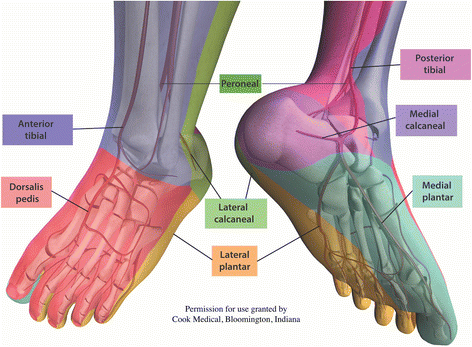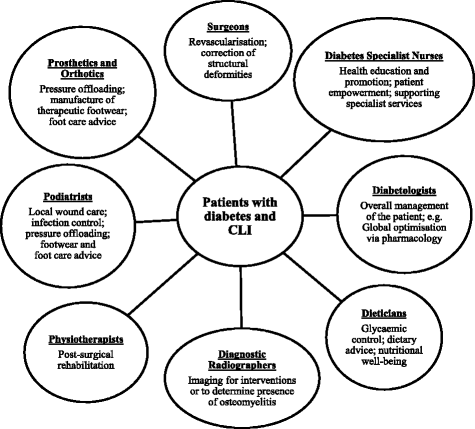The comparative efficacy of angiosome-directed and indirect revascularisation strategies to aid healing of chronic foot wounds in patients with co-morbid diabetes mellitus and critical limb ischaemia: a literature review
- PMID: 28670345
- PMCID: PMC5490238
- DOI: 10.1186/s13047-017-0206-5
The comparative efficacy of angiosome-directed and indirect revascularisation strategies to aid healing of chronic foot wounds in patients with co-morbid diabetes mellitus and critical limb ischaemia: a literature review
Abstract
Background: Ischaemic ulcerations have been reported to persist and/or deteriorate despite technically successful revascularisations; a higher incidence of which affects patients with diabetes and critical limb ischaemia. In the context of wound healing, it is unclear if applications of the angiosome concept in 'direct revascularisation' (DR) would be able to aid the healing of chronic foot ulcerations better than the current 'best vessel' or 'indirect revascularisation' (IR) strategy in patients with co-morbid diabetes and critical limb ischaemia.
Methods: A literature search was conducted in eight electronic databases, namely AMED, CINAHL, The Cochrane Library, ProQuest Health & Medicine Complete, ProQuest Nursing & Allied Health Source, PubMed, ScienceDirect and TRIP database. Articles were initially screened against a pre-established inclusion and exclusion criteria to determine eligibility and subsequently appraised using the Newcastle-Ottawa Scale.
Results: Five retrospective studies of varying methodological quality were eligible for inclusion in this review. Critical analysis of an aggregated population (n = 280) from methodologically stronger studies indicates better wound healing outcomes in subjects who had undergone DR as compared to IR (p < 0.001; p = 0.04). DR also appears to result in a nearly twofold increase in probability of wound healing within 12 months (hazard ratio, 1.97; 95% CI, 1.34-2.90). This suggests that achieving direct arterial perfusion to the site of ulceration may be important for the healing of chronic diabetic foot ulcerations.
Conclusion: Incorporating an angiosome-directed approach in the lower limb revascularisation strategy could be a very useful adjunct to a solely indirect approach, which could increase the likelihood of wound healing. With the limited data currently available, findings appear promising and merit from further investigation. Additional research to form a solid evidence base for this revised strategy in patients with co-morbid diabetes and critical limb ischaemia is warranted.
Keywords: Angiosome; Critical limb ischaemia; Diabetic foot; Peripheral vascular disease; Revascularisation; Wound healing.
Figures
References
-
- Norgren L, Hiatt WR, Dormandy JA, Nehler MR, Harris KA, Fowkes FGR. Inter-society consensus for the management of peripheral arterial disease (TASC II). J Vas Surg. 2007;45(1):S5–S67. Available from: doi:10.1016/j.jvs.2006.12.037. Accessed 21 Oct 2015. - PubMed
-
- Game FL, Apelqvist J, Attinger C, Hartemann A, Hinchliffe RJ, Löndahl M, et al. IWGDF guidance on use of interventions to enhance the healing of chronic ulcers of the foot in diabetes. Diabetes Metab Res Rev. 2015;32(Suppl S1):75–83. Available from: doi:10.1002/dmrr.2700. Accessed 13 Jan 2016. - PubMed
-
- Jaff MR, White CJ, Hiatt WR, Fowkes GR, Dormandy J, Razavi M, et al. An Update on Methods for Revascularization and Expansion of the TASC Lesion Classification to Include Below-the-Knee Arteries: A Supplement to the Inter-Society Consensus for the Management of Peripheral Arterial Disease (TASC II). J Endovasc Ther. 2015;22(5):663–77. Available from: doi:10.1177/1526602815592206. Accessed 13 Nov 2015. - DOI - PubMed
Publication types
MeSH terms
LinkOut - more resources
Full Text Sources
Other Literature Sources
Medical




